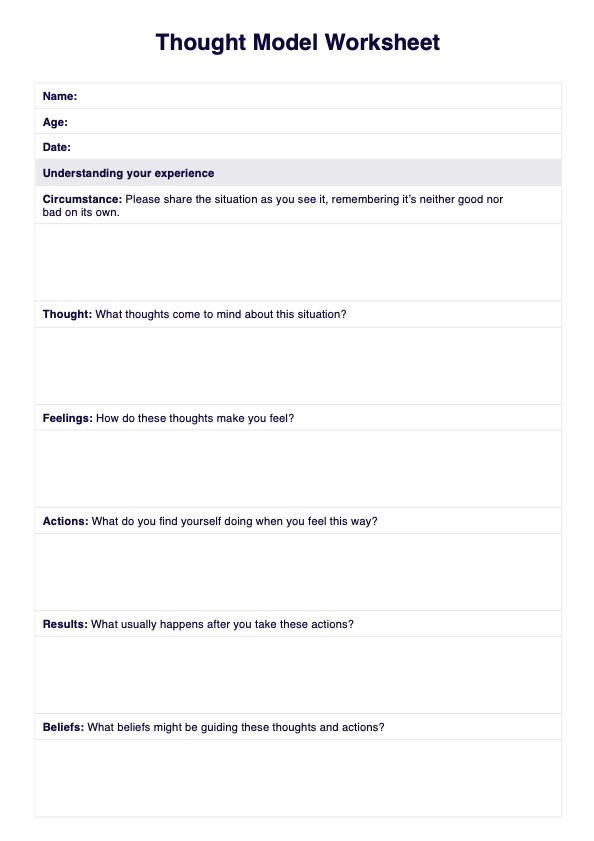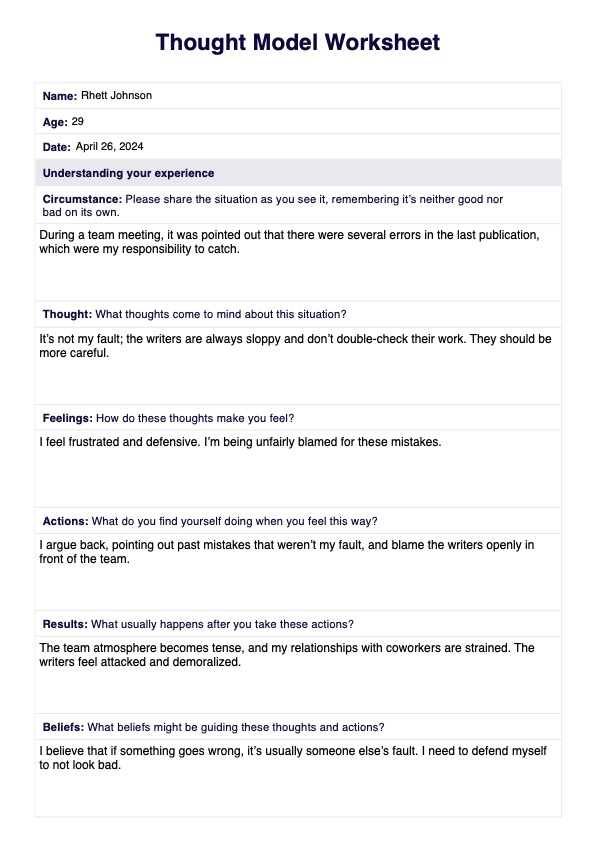Thought Model Worksheet
Unlock the benefits of cognitive restructuring with our Thought Model Worksheet, designed to enhance therapy sessions and improve mental health outcomes.


What is cognitive behavioral therapy?
Cognitive behavioral therapy (CBT) is a form of psychological treatment that has proven effective for a range of problems, including depression, anxiety disorders, alcohol and drug use issues, marital problems, eating disorders, and severe mental illness. Numerous research studies suggest that CBT significantly improves functioning and quality of life (APA Div. 12, 2017).
In CBT, therapists and patients work together to identify and understand problems regarding the relationship between thoughts, feelings, and behaviors. It focuses on changing unhelpful or unhealthy thoughts and behaviors. It combines two therapies: ‘cognitive therapy’ and ‘behavioral therapy.’ The premise behind cognitive therapy is that thoughts lead to feelings, feelings lead to behaviors, and behaviors reinforce thoughts.
CBT has a substantial research base and is considered the gold standard in the psychotherapeutic treatment of anxiety disorders (David et al., 2018).
Thought Model Worksheet Template
Thought Model Worksheet Example
What is cognitive restructuring in CBT?
Cognitive restructuring is a core component of CBT that involves identifying and challenging negative and irrational thoughts to replace them with more balanced and constructive ones.
Cognitive restructuring helps individuals become aware of cognitive distortions — unhelpful patterns of thinking that often underpin dysfunctional emotions and behaviors, such as automatically assuming something is impossible or self-hate.
The process typically involves several steps: recognizing the thoughts contributing to problematic emotions, analyzing them to assess their validity, and then restructuring them to lead to healthier emotional responses and behaviors.
Cognitive restructuring is not just about changing thoughts but also about changing the emotional and behavioral responses associated with them. This approach is instrumental in treating various mental health conditions by helping individuals develop more flexible and adaptive thinking patterns.
What is a Thought Model Worksheet?
A Thought Model Worksheet is a practical tool used in Cognitive Behavioral Therapy (CBT) to facilitate cognitive restructuring. It helps clients identify and analyze their thoughts, feelings, and behaviors in response to a specific event or situation. By breaking down these responses, the worksheet assists individuals in understanding the connections between their thoughts and their emotional and behavioral reactions.
The purpose of a Thought Model Worksheet is to guide individuals through recognizing and altering maladaptive thoughts. It enables them to map their cognitive processes, see where they might be making cognitive distortions, and explore more adaptive thoughts and beliefs. The ultimate goal is to empower individuals to change their thinking patterns, which can lead to more positive emotional responses and functional behaviors in similar future situations.
How does our Thought Model Worksheet work?
Our Thought Model Worksheet is meticulously designed to support the process of cognitive restructuring within a therapeutic context. It contains sections for identifying and analyzing a client’s initial thoughts and reactions to a situation, which then helps them explore alternative, more adaptive thoughts and responses.
Step 1: Access this template
The first step for healthcare professionals is to access the template. It is available digitally on the Carepatron platform but is also printable, allowing therapists to integrate it into telehealth and face-to-face sessions easily. It can also be sent to the patient for them to accomplish.
Step 2: Explain the template
Before starting the worksheet, therapists must explain its structure and purpose to the patient. This involves walking through each section of the template to clarify what types of information the patient will need to provide. This explanation helps set the stage for a productive session, ensuring that the patient understands how examining their thoughts, feelings, and behaviors can lead to significant changes in their outlook and mental health.
Step 3: Fill out the template
As the session progresses, the therapist guides the patient through filling out each part of the worksheet. They begin with the patient’s initial reactions to a specific circumstance and move through detailed inquiries about their thoughts, feelings, and resulting actions. Alternatively, the patient can fill it out after the session is done, and they can send it back to you via the patient portal.
Step 4: Analyze and discuss the findings
After completing the worksheet, you and the patient review the information, discussing the connections between different sections. You can do this online or in the next session, too. This discussion is crucial for helping the patient understand how their initial thoughts can lead to emotional and behavioral patterns that might be unhelpful or damaging.
Step 5: Develop new strategies
Based on the insights gained from the worksheet, help the patient develop new, healthier thought patterns and coping strategies. This may involve setting practical goals, practicing new cognitive skills, or preparing responses for similar future situations.
Benefits of thought modeling
Thought modeling offers many benefits that can significantly enhance the therapeutic process and improve mental health outcomes. This approach helps address current issues and equips individuals with skills that are beneficial long-term.
- Enhanced self-awareness: Thought modeling encourages individuals to examine their thoughts and emotions deeply, leading to greater self-awareness. This heightened understanding allows people to notice problematic patterns contributing to their distress.
- Reduced emotional distress: By identifying and adjusting negative thought patterns, individuals can reduce the intensity of negative emotions such as anxiety, depression, and anger. This adjustment helps mitigate emotional responses to stressors, fostering a more stable and feel-good emotional state.
- Improved problem-solving skills: Thought modeling teaches individuals to approach problems with a more balanced and reflective mindset. This skill is crucial not only in personal scenarios but also in navigating complex interpersonal situations.
- Enhanced coping strategies: Individuals develop more robust coping mechanisms as they learn to alter their cognitive patterns. These new strategies enable them to improve confidence and handle future challenges more effectively, reducing the likelihood of old patterns re-emerging.
- Better relationships: Thought modeling can improve interpersonal relationships by reducing conflict and enhancing understanding between individuals. As people learn to manage their thoughts and reactions, they become better communicators and more empathetic partners or colleagues.
Who can benefit from thought modeling?
Thought modeling is a versatile therapeutic tool that can aid a diverse range of individuals:
- Individuals with anxiety disorders: Those struggling with anxiety can learn to manage irrational fears and anticipatory thoughts, reducing anxiety levels significantly.
- People experiencing depression: By challenging negative self-beliefs and catastrophic predictions, individuals with depression can develop a more balanced perspective that supports mood improvement.
- Professionals in high-stress jobs: Thought modeling can help professionals manage stress and prevent burnout by fostering more resilient thought patterns.
- Couples facing communication challenges: Couples can use thought modeling to break down recurring conflicts and develop healthier ways of relating to each other.
These benefits underline why thought modeling is crucial to modern therapeutic practices and applicable across various conditions and settings.
Helpful resources on identifying and changing thought patterns
Several resources developed by Carepatron are available for those seeking tools to understand better and transform their thinking patterns. These tools help individuals recognize, document, and address unhelpful cognitive patterns, enhancing their mental health and emotional well-being.
- Thought Record Template: This template assists clients in creating thought records, where they can note incidents that trigger emotional reactions, identify their thoughts and feelings, and evaluate these thoughts to foster healthier thinking patterns.
- Automatic Negative Thoughts Worksheet: Designed to help individuals quickly identify and address spontaneous negative self-talk, this worksheet supports breaking cycles of negativity and promotes healthier mental habits.
- Challenging Negative Thoughts Worksheet: This tool guides users through recognizing and challenging their negative thoughts, helping replace them with more positive and realistic perspectives.
These resources are free and can be accessed directly through the Carepatron platform, making them easily integrated into therapeutic settings and personal self-help routines. You can also apply this cognitive distortions template to refine your practice and optimize client outcomes.
References
American Psychological Association. (2017). What is cognitive behavioral therapy?. https://www.apa.org/ptsd-guideline/patients-and-families/cognitive-behavioral
David, D., Cristea, I., & Hofmann, S. G. (2018). Why cognitive behavioral therapy is the current gold standard of psychotherapy. Frontiers in Psychiatry, 9(4), 1–3. https://doi.org/10.3389/fpsyt.2018.00004
Commonly asked questions
A thought model is a framework used in cognitive therapy to identify and understand the relationships between thoughts, emotions, and behaviors, helping individuals modify problematic thinking patterns.
Model thinking is crucial as it allows individuals to systematically break down and analyze their thought processes, leading to more effective management of emotional responses and behavior patterns.
A thought record sheet is a tool that helps individuals document their automatic thoughts, emotions, and the contexts in which they occur, facilitating deeper insight and cognitive restructuring.

























-template.jpg)













































































